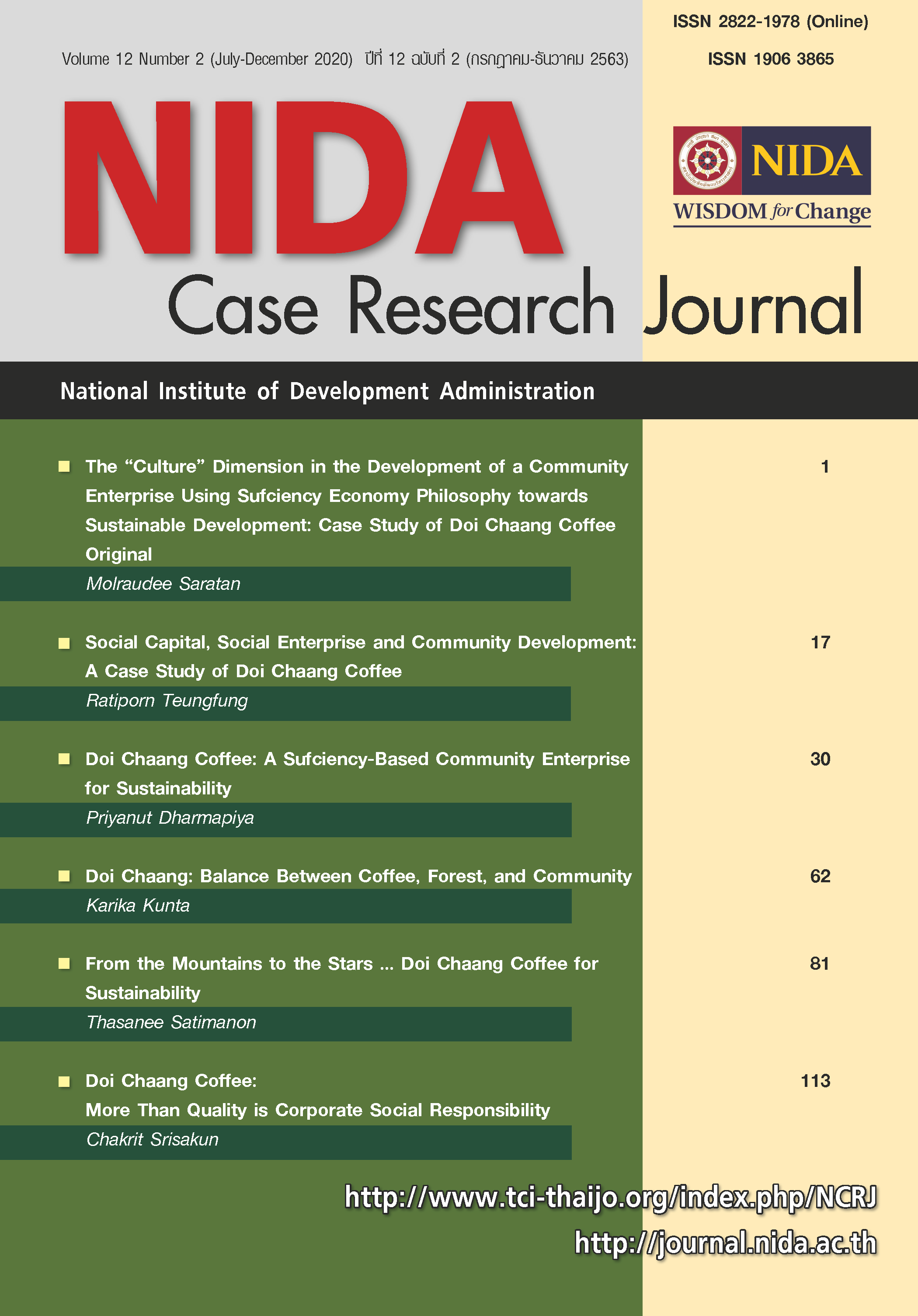Doi Chaang: Balance Between Coffee, Forest and Community
Keywords:
Agrotourism, Organic farming, Doi Chaang, Coffee tourism, ForestAbstract
Doi Chang Village is in Wawee, Chiang Rai, on the mountain peak, near the source of a river and the home of hill tribes; Akkha, Lisu. In the past, swidden agriculture was practiced, resulting in forest clearance and natural resource depletion. In 1969, His Majesty the King Rama IX initiated a project for local communities in order to decrease opium production and swidden cultivation. With various projects, the hill tribe farmers have been encouraged to grow cash crops with perennials; they began to grow Arabica coffee. Until now, the area devoted to Arabica coffee cultivation was 30,000 Rai, including the forest that had become fertile again. In 1990, a company was established under the name “Doi Chaang Coffee Original Company Limited”. Later, it developed into a world class coffee brand. The company developers have been accepted in the business and local communities, due to changes in cultivation habits and in forestation.
Sukkamon Thepin was a typical Doi Chaang Akha teenager and worked in his family organic coffee farm. He was fond of farming activities; however, he saw an opportunity for a CBT or Agrotourism or “coffee tourism”. Doi Chaang Academy would be an attraction, excluding beautiful nature, coffee farm and friendly community. Sukkamon needed to scrutinize the social-economic and environmental impact, and community acceptance. Since Sukkamon’s family was a member of the company, on 30 June 2020, he would need to present his idea to the company board and some community members to get funds for developing coffee tourism.
References
Angkasith, P. (2001). Coffee Production Status and Potential of Organic Arabica Coffee in Thailand. Paper presented at the First Asian Regional Roundtable on Sustainable, Organic and Specialty Coffee Production, Processing and Marketing, Feb 26-28, 2001, Chiang Mai, Thailand.
Daengtuy, C., Kornochalert, S. & Manoruang, W. (2017). Effect of Coffee Ground and Coffee Husk Bio-extracts on Growth of Brassica rapa L. Phranakhon Rajabhat Research Journal (Science and Technology), 18(2), 54 -63. (in Thai)
Chase, L.C., Stewart, M., Schilling, B., Smith, B. & Walk, M. (2018). Agritourism: Toward a Conceptual Framework for Industry Analysis. Journal of Agriculture, Food Systems, and Community Development, 8(1), 13–19.
Department of Intellectual Property. (2014). About the issue: Doi Tung Coffee and Doi Chaang Coffee progress in registered GI in Europe. 1P Journal 10, 3-4.
Diyah Setiyorini, H.P. (2018). Coffee Tourism Development Potential: Benefit and Consequences. Advances in Social Science, Education and Humanities Research, 259, 154-157.
FAO. (2017). Conservation Agriculture.
Jha, S., Bacon, C., Philpott, S., Rice, R., Méndez, V.E. & Läderach, P. (2011). A Review of Ecosystem Services, Farmer Livelihoods, and Value Chains in Shade Coffee Agroecosystems. In Integrating Agriculture, Conservation and Ecotourism: Examples from the Field, 141–208.
Jolliffe, L. (2010). Coffee Culture, Destination, and Tourism. Bristol: Channel View.
Klein, A., Steffan-Dewenter, I. & Tscharntke, T. (2003a). Pollination of Coffea canephora in relation to local and regional agroforestry management. Journal of Applied Ecology, 40, 837-845.
Klein, A., Steffan-Dewenter, I. & Tscharntke, T. (2003b). Fruit set of highland coffee increases with the diversity of pollinating bees. Proceedings of the Royal Society of London, 270, 955-961.
Ministry of Tourism and Sports. (2017). Tourism Economic Review, 7 (January – March). Available at: www.mots.go.th/ewt_dl_link.php?nid=8265 (accessed 10 February 2020).
Prachachat Business, 30 August 2017. The production of Arabica coffee in Chiang Rai skyrocketed by 4 thousand tons. Doi Chaang pushes "premium geisha" coffee at 8 thousand per kilogram! Access at: https://www.prachachat.net/local-economy/news-31135
Perdergrast, M. 2015. How One Small Coffee Company Helped Transform a Hillside Village in Thailand: Beyond Fair Trade. Vancouver: Greystone Books.
Pinthukas, N. & Angkasith, P. (2017). Arabica Coffee Farming Extension Pattern and Process in Royal Project and Highland Development Project Using Royal Project System. KHON KAEN AGR. Journal 45(1), 521 – 526.
Ritpreecha, O. (2011). Doi Chaang Coffee Original 2. Chiang Mai: Pongsawas Printing. (in Thai)
Smith, N., Suhtitakon, N., Guthawatvichai, T. & Karnjanakit, S. (2019a). Creating a coffee tourism network in the north of Thailand. Local Economy, 34(7), 718-729.
Smith, N., Suhtitakon, N., Guthawatvichai, T. & Karnjanakit, S. (2019b). The Circumstances Pertaining to the Behaviors, Demands and Gratification in Tourist Engagement in Coffee Tourism. PSAKU International Journal of Interdisciplinary Research, 8(1), 211-233.
Suwanwisolkit, P. (2008). Production Efficiency of Arabica Coffee in Northern Thailand. Chiang Mai: Highland Research and Training Center. (in Thai)
Tan, C.C., Sitikan, B., Anomasiri, S. & Pathan, A. (2018). A Social and Cybernetic Psychological Model for the Social Entrepreneurship-driven Community-based Tourism (CBT) Development in Chiang Rai, Thailand. International Journal of the Science and Innovative Technology, 1(1), 44-61.
Downloads
Published
How to Cite
Issue
Section
License
Copyright (c) 2024 NIDA Case Research Journal

This work is licensed under a Creative Commons Attribution-NonCommercial-NoDerivatives 4.0 International License.





